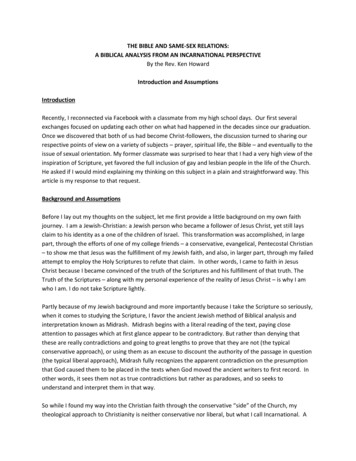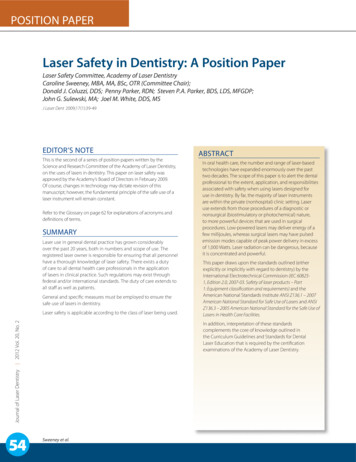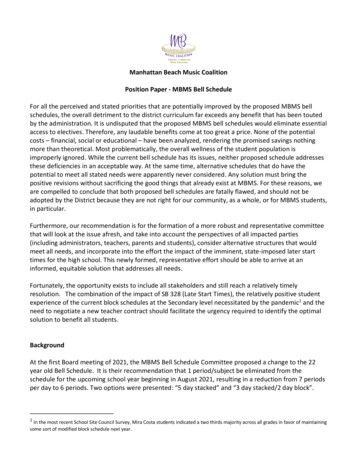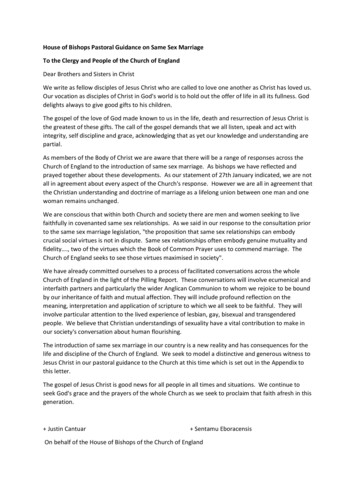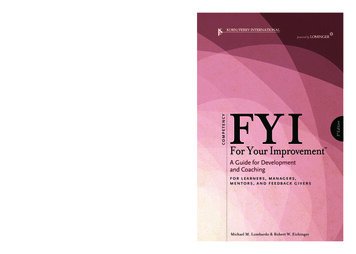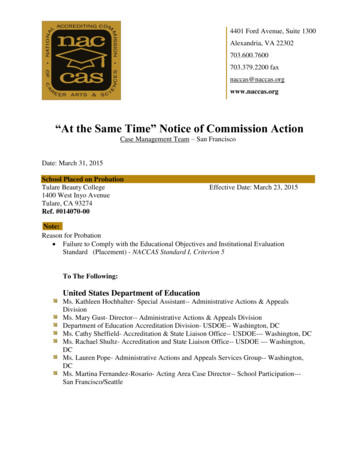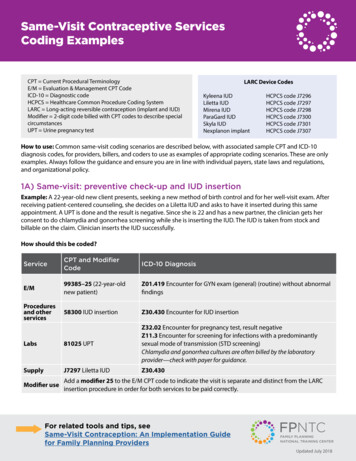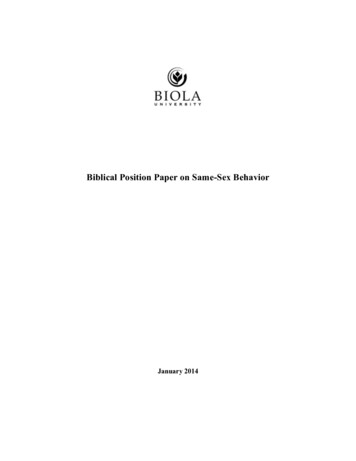
Transcription
Biblical Position Paper on Same-Sex BehaviorJanuary 2014
Biblical Position Paper on Same-Sex BehaviorScholars from Biola University wrote and edited this paper, drawing from their expertise andtraining in the New Testament, the Old Testament and Theology. It is intended to provide athoughtful, expository survey on the topic of same-sex behavior from a biblical perspective. It isnot intended to be either a comprehensive or an exhaustive survey of the topic of homosexualityor sexual identity.2
Biblical Position Paper on Same-Sex Behavior3Biblical Position Paper on Same-Sex BehaviorI.IntroductionAt present questions of human sexuality, sexual identity, and the parameters of marriage are acentral focus in our culture. Discussion of these issues both in the context of cultural commentaryand legal discourse has moved ahead without reference to biblical teaching or Christian tradition.Thus the need for a clear voice from a biblical perspective on these matters is critical, both for thehealth of the Biola community and for our faithful witness to the world.This paper, reflecting directly on Scripture as our ultimate authority, sets forth a biblicalperspective on human sexuality, specifically with reference to same-sex activity. Though the issuesof same-sex attraction and the question of whether individuals are born homosexual are of crucialimportance and need to be addressed in the Biola community, the scope of this paper will belimited to what the Bible teaches regarding same-sex behavior (leaving aside sexual identity ororientation). Furthermore, any commentary on this topic is incomplete without considering thebroader Christian vision of human sexuality as a good gift of God outlined in Scripture. God’sdesign for sexual expression within the covenant of marriage between a man and a woman isfundamental to the well-ordering of human society and is integral to human flourishing. Though acomplete discussion of human sexuality in light of Scripture’s teaching is the ideal, the particulargoal of this paper is to articulate briefly what we, as the Biola community, understand Scripture toteach regarding same-sex sexual activity.As Christians, we have been called to holiness through obedience to God’s Word in all matters.Scripture says, “But as He who called you is holy, you also be holy in all your conduct, since it iswritten, ‘You shall be holy, for I am holy’” (1 Pet. 1:15-16).1 Our goal is to glorify God by livingaccording to His Word and His desires for humanity, and our views on sexuality must be seenaccording to this larger purpose. We also affirm that the pursuit of holiness must be done in thecontext of a loving and committed community of God’s people as we wrestle with the implicationsof both our fallenness and our renewal in Christ.All Biola University Community Standards are grounded in our long-standing identity asexpressed in our Doctrinal Statement and Student Handbook. These documents are intended tocommunicate the teachings of the Bible and our institution’s historic Protestant theology. As such,our university community “is born of other-centered practices, strengthened when members livewith integrity, practice confession and forgiveness, attempt to live in reconciled relationships,accept responsibility for their actions and words, and submit to biblical instruction.”2 As acommunity of committed followers of Jesus Christ we have agreed to study and live togetherobeying the commands of Scripture while giving and receiving the grace of the gospel—acommunity of holiness and redemption.Of particular relevance to our position on same-sex sexual activity are the following passages.From the Doctrinal Statement: “Man was created in the image of God, after His likeness, but thewhole human race fell in the fall of the first Adam.”3 And from our Community Standards:
Biblical Position Paper on Same-Sex Behavior4“Furthermore, students at Biola commit to refrain from practices that Scripture forbids, such as,sexual relations outside of marriage, homosexual behavior, theft and dishonesty.”4 The StudentHandbook expands upon the Community Standards and further outlines the ways in which samesex behavior is to be addressed:When a student approaches [Student Development] and communicates that he or she isstruggling with same-sex behavior, same-sex attraction and/or sexual orientation issues we aimto offer safety that promotes openness. We pledge to extend compassion and carecommunicating personal acceptance, while providing accountability and assistance supportingstudents in their desire to live consistently with Christian teaching.5Furthermore, the handbook emphasizes the redemptive and restorative context within which thecommunity goal of living in step with the teaching of Scripture must take place.Due to the complexity of issues related to same-sex behavior, same-sex attraction and sexualorientation, we are committed to engaging this conversation with courage, humility,prayerfulness and care. We believe, in accordance with Scripture, that we are all broken.Therefore, a primary goal of Student Development at Biola is to help each student find God inthe midst of their unique history and struggles and discern how to walk with Him and othersalong the way.6II.FrameworkforStudy:ARedemptive- ‐HistoricalPerspectiveBiola University’s foundation for understanding human personhood, gender, sexualidentity, and same-sex sexual activity is rooted in the Scriptures as divine revelation. Thisis in accordance with Biola University’s doctrinal statement regarding the Bible:The Bible, consisting of all the books of the Old and New Testaments, is the Word ofGod, a supernaturally given revelation from God Himself The Scriptures of the Oldand New Testaments are without error or misstatement in their moral and spiritualteaching and record of historical facts. They are without error or defect of any kind.7As Scripture is our ultimate authority, it is important to note first of all that the Bible isnot primarily a book about human ethics. Though Scripture has much to say about howwe live and act, it is not merely a manual for moral living. Rather, the emphasis ofScripture is on God’s will and activity in creation, redemption, and ultimately, theconsummation of all things. When interpreting individual passages of Scripture, one mustunderstand how that particular passage fits within the overarching narrative of Creation,Fall, Redemption, and finally, Re-creation or Consummation.In the beginning, God created all things by His own power and for His own expresspurposes. God reveals His holiness by His unwavering commitment to all that He createdand saw as very good (Gen 1:31). But of course that is not the whole story. We learnfrom Genesis 3 that God’s good creation, humanity specifically, rebelled against God’sorder and purpose. The rest of Scripture and human history must now be understood inlight of God’s good and purposeful creation on one hand, and human rebellion and
Biblical Position Paper on Same-Sex Behavior5rejection on the other. The only solution to the fracture and dislocation caused by humansin is God’s redemption in Christ. Thus the overarching story of Scripture is the story ofcreation, fall, redemption, and ultimate restoration. From the Garden to Gethsemane and,ultimately, to the New Heavens and the New Earth, Creation, Fall, and Redemptionbecome the major topographical landmarks that help us travel along Scripture’s big idea.Because the subject of the Bible is God and his redemption, we need to ask secondly,how does Scripture, then, apply to us? A Christian reading of Scripture should alwayshave an eye toward obedient response. How shall we then live in response to what Godhas said? This is the receptive reading of a disciple. But again, because the story ofScripture is first and foremost about God, how might we understand our place in thatstory? Rather than thinking about how God’s reality might fit into my own, it is best tothink about how my life’s narrative is taken up into that of God’s. My story now must bereconfigured within God’s story of redemption if my life or my actions are to make anysense at all. Seeing my life’s story within God’s transforms how I understand my past(the ultimate beginning is creation) and my future (the ultimate end is God’seschatological redemption of all things). And, re-inscribed within this new storyline, Icome to understand my actions, attitudes, goals, and desires as reordered by a new andlarger (and much more compelling) purpose now narrated by Scripture.As indicated above, Biola University seeks to ground its viewpoint about all issues in thetruth of Scripture . . . our goal being to think biblically in all areas of life. With Scriptureas our ultimate authority, we believe that human sexuality is a good gift of God. The GodWho created us, as with all His gifts to us, has also provided instruction and guidance forthe proper use of the gift of sex within human relationships. In the following sections weexplore this guidance in the Old and New Testament Scriptures, seeking to understandGod’s perspective and how to think biblically about our stamentThis section of the biblical statement focuses upon information in the instruction from theOld Testament. While there is much instruction about human relationships to be foundhere, the discussion will focus upon the topic of homosexuality.The Genesis Model—Monogamous, Heterosexual MarriageBiola’s official statement on human sexuality8 states the following:Biola University affirms that sexual intimacy is designed by God to be expressedsolely within a marriage between one man and one woman. This view of sexualityand marriage is rooted in the Genesis account of creation, reflected in the teachings ofJesus Christ himself, and is maintained consistently throughout Scripture. It is a viewbased on the biblical teaching of monogamy—that God designed sexual union for thepurpose of uniting one man and one woman into a permanent, lifelong, one fleshunion in the context of marriage. God created two complementary forms of humans,male and female, to bear His image together (Gen 1:27-28), and ordained that the firsthuman pair were to become one flesh (Gen 2:23-24). These and other similar
Biblical Position Paper on Same-Sex Behavior6passages show that God views sex, procreation and marriage as good, and that maleand female are necessary counterparts—differentiated partners—in a sexualcomplementarity. Sexual intimacy and the sexual union of intercourse between aman and a woman are intended for a purpose—to join one husband and one wifetogether into one flesh in the context of marriage (I Cor 6:16).Since the Scriptures begin with specific information about the first marriage in theGarden of Eden, we too are compelled to begin there in our views of man, woman,marriage, and sexuality. God’s creation of human beings as male and female (Gen 1:27)is the foundation of human sexuality. This complementarity in the human relationshipreflects an essential part of our creation “in His image” (Gen 1:26-27; 5:1, 3). Thecreation mandate, “Be fruitful and multiply and fill the earth and subdue it . . .” (Gen1:28) further reflects a major purpose of human sexuality, that those who carry God’simage will multiply in order to subdue the earth.Therefore, the monogamous relationship between a man and a woman created by God(Gen 2:18-25) becomes our model of marriage. The import of this “one flesh” union isshown to be even more significant when it is later revealed this union was intended to bea visible illustration of Yahweh’s relationship with Israel and Christ’s relationship withthe church today (Isaiah 54:5-6; Eph 5:22-33). The Genesis story of the first marriage isnot just providing precedent, but mysteriously pictures our human relationship with God.As such, it serves as the basis for later warnings about behavior that violates theboundaries of this model, including heterosexual activity outside marriage andhomosexual behavior.The Effects of the Fall of the Human Race into Sin and God’s Offer of RedemptionThe Old Testament celebrates human sexuality as a gift from God. Expressions of thebeauty of love and romance are found in diverse contexts, like the poetry of Song ofSongs, or in the beautiful narrative love story of Ruth and Boaz. In order to protect thebeauty and sanctity of this relationship, the Old Testament Scriptures are also replete withwarnings about violations of this covenant—e.g., adultery, premarital sex, rape, andprostitution.Much of the discussion among Christians about these topics, as well as subjects likehomosexuality, has focused upon prohibitions. While the “Thou shalt not’s” in Scriptureare important, they must be seen and discussed in light of the reason for their existence—the fall of the human race into sin. From the independent, rebellious act of Adam and Eve(Gen 3:1-7) came a radical change in every aspect of human life (Gen 3:8-24). All humanbeings, and every part of our humanness, including our sexuality, have been deeplydamaged by sin (Rom 1:21-32). We are all sinners, broken in some measure by this fall,but we are not left in a hopeless state. God’s redemptive power offers to rescue us, toreconcile us to Him, and to empower us to live in obedience to God’s design. Ifeverything in our lives has in some way been touched by the effects of the fall, we canexpect that our sexual nature is included. Addictive behaviors, heterosexual desire andbehavior outside of a marriage commitment, homosexual desire and activity—all of these
Biblical Position Paper on Same-Sex Behavior7result from our fallenness. Temptation, including sexual attractions, is not sin. Sin isyielding to temptation in an area of behavior that is specifically identified as wrong.Since the concept of a universal “fall” is rarely believed, taught, or even known outsideof Christian teaching, the following assumption is commonly embraced by
Biblical Position Paper on Same-Sex Behavior 2 Scholars from Biola University wrote and edited this paper, drawing from their expertise and training in the New Testament, the Old Testament and Theology. It is intended to provide a thoughtful, expository survey on the topic of same-sex behavior from a biblical perspective. It is not intended to be either a comprehensive or an exhaustive survey .

